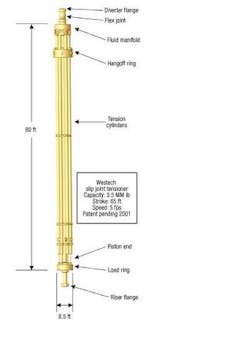FLOATOVER TECHNOLOGY:Self-contained mooring system extends rig range in deepwater
Thor Haavie
Tor Kvillum
Hitec Framnes
Tim Mournian
Jim Adams
WesTech/Control Flow
Hitec Framnes is developing HiMoor, a self-contained, pre-laid mooring system for deepwater, to improve drilling efficiency at a low cost in deepwater. A second-generation semisubmersible moored by HiMoor may carry out deepwater drilling operations that would otherwise require a fourth-generation semisubmersible.
HiMoor reduces the variable deck load required for such operations and contributes to faster and safer operational procedures.
One of the special equipment features contributing to these efficiency improvements is the wet riser tensioner system that is operated from HiMoor. This system will replace the traditional riser tensioner systems mounted in high-up positions on older semisubmersibles.
Market drivers
Deepwater E&P has become a business and technology challenge. Water depth and hole depth ambitions have grown rapidly. Operations in 1,000-1,500 m are now commonplace, and drilling and production work in water depths of 1,800-2,500 m are not uncommon.
null
New semisubmersibles with more deck load carrying capacity have been built, some with advanced, and heavy, anchor systems installed and some with comprehensive dynamic position (DP) keeping systems. Many older semisubmersibles have been upgraded more than once to carry out work in greater water depths. The Borgsten Dolphin Aker H3 model may serve as an example in that respect: Its deck load carrying capacity has been increased from about 1,800 metric tons to 2,900 tons. Yet another upgrade (by increasing waterplane areas and pontoon displacement) to 4,500-5,000 tons carrying capacity would most likely lead to structural absurdities and would also become a bad economical proposition.
Accordingly, instead of embarking upon comprehensive semisubmersible modifications, pre-laid anchor systems have been devised and successfully applied. Such a system can convert part of the anchor system associated weights of older semisubmersibles to useful deck load. This makes such vessels viable for deepwater applications.
DP semisubmersibles are, of course, tailor-made for deepwater work. Most were delivered after 1990 and have ample deck load carrying capacity for work in deepwater. Some Gulf of Mexico operators, however, do not favor production drilling from DP floaters.
The HiMoor, pre-laid mooring arrangement differs from traditional pre-laid anchor systems. A recently completed study suggests that a second-generation semi with deck load capacities in the range of 2,000-3,000 tons moored by means of a HiMoor system may carry out work that otherwise would require a fourth-generation semisubmersible with variable deck load capacities between 4,000 and 4,500 tons. Alternatively, new semis intended to operate anchored in ultra-deepwaters, more than 1,500 m deep, can be designed as considerably smaller, less expensive units and still maintain fourth-generation semi capabilities.
To illustrate these advantages, Hitec Framnes has a new semisubmersible design, the FE-P007, with an operating displacement of less than 15,000 metric tons, design variable deck load of 3,000 tons, and a price tag under $100 million, exclusive of the topsides drilling equipment.
This vessel, as well as the Borgsten Dolphin, would, by means of a HiMoor station-keeping system, be able to work in areas otherwise reserved for semis with variable deck loads in the range of 4,000-4,500 tons.
Design objectives
The overriding design objective is to devise and describe an anchor system that may be pre-laid in ultra-deepwaters, which is "fit for a defined purpose" and associated with a low acquisition cost, low deployment costs, low repair and maintenance costs, simple and reliable attachment (between HiMoor and semisubmersible) mechanics characteristics, and has features to improve drilling operations.
The HiMoor can increase the variable deck load capacity of existing semisubmersibles, or new designs, without comprehensive and expensive modifications to the units. The system will:
- Enable new semisubmersibles to be designed as smaller and less expensive units, with variable deck load characteristics as those usually associated with larger units
- Provide an underwater platform where a riser tensioner system may be installed, allowing for the removal of heavy, traditional, topsides riser tensioner systems on existing units
- Provide an underwater platform, which may be used to hang off long tubular assemblies and thereby improve the efficiency of the early phase (in particular) of a drilling operation
- Provide a safe mooring facility, exhibiting quick attachment and disconnection features for a semisubmersible
- Facilitate quick disconnection in bad weather with minimal risk of injuries to personnel
- Require a low capital investment relative to the increase in earning potential of a semisubmersible.
Ultimately, the commercial success or failure of such a development project depends on the designers' ability to weigh often-contradictory design parameters. The introduction of new physical features during the design process can lead to unexpected gains or losses. In the case of HiMoor attached to a semisubmersible, the stability issue may hold some surprises.
Other considerations include the market, an aging fleet of semisubmersibles, and the discovery of potential hydrocarbons in ever increasing water depths. All these factors lead to the specific objective of designing a better pre-laid mooring system with performance enhancing features.
Criteria
Currently, the HiMoor System is proposed for worldwide application in a relatively benign environment, such as the GoM. Such a design allows the use of existing anchor systems on older semisubmersibles. In the future, HiMoor may be part of a new semi design, suitable for harsh environments.
The main design criteria in respect to environment, equipment, and operational requirements include a floating body with a simple geometry. This structure would be anchored on a deepwater site before the arrival of a semisubmersible drilling unit.
null
HiMoor will accommodate the mating and attachment of the pre-laid mooring system to the semi. The HiMoor and semi will not use mechanical clamping devices or attachment wires, and the system must maintain "high accuracy position" relative to a seabed target during extreme GoM winter storm conditions. Drilling operations through the semisubmersible/HiMoor moonpools should be able to continue during such coincident wind, wave, and current conditions.
Operations conducted from a semi attached to HiMoor may be terminated in a controlled manner, and the rig detached from HiMoor in less than 10 hours. HiMoor would remain on station to ride out the hurricane, in a submerged condition with the riser hanging in HiMoor and the lower marine riser package (LMRP) on the seabed. The HiMoor can be ballasted to a desirable submersion depth using remote and signal cable control from a supply ship or the semisubmersible.
HiMoor's fairleads and stoppers will handle the same dimensions of stud-link chain as the existing mooring lines for the particular semisubmersible. However, eight lengths of about 250-ft new anchor chains, with the same stud-link characteristics need to be preinstalled on HiMoor.
This would allow the use of existing winch machinery and fairleads on the semisubmersible, and probably avoid structural reinforcements for fairlead and winch support.
Although traditional, dry riser tensioner systems are located above the drill floor level on semis, a wet riser tensioner system will be installed on HiMoor. This lowers the semi's center of gravity and substantially increases its variable deck load. The lowest point of horizontal restraint for a wet riser tensioner system installed on HiMoor will be significantly lower than the corresponding point for a traditional dry system. The lower position of the point of attack of the vertical component of the resultant riser tension force will therefore reduce the required total deck load carrying capacity of the semisubmersible (during drilling operations) by 500 to 1,000 tons.
Design solutions
A number of proposed HiMoor geometries were investigated to determine which would meet the technical and economic requirements. Clearly, the larger the HiMoor displacement volume, the less stable the HiMoor/semisubmersible assembly will be.
There are other reasons for making HiMoor as small as possible, such as the effect of size on motion responses and wave and current drag forces.
null
HiMoor's main body consists of four buoyancy sections, symmetrically arranged as two water ballast tanks on the port side and two on the starboard side of a centerline. The port and starboard tanks are interconnected by a strong, open-to-sea, box girder type structure. This provides attachment facilities and shielding for ventilation pipes, cables, and valves. The tank top structures act as support surfaces beneath the near midship area of each of the pontoons on the semisubmersible.
A friction fender atmospheric attachment system (Ffaas) is arranged on top of the ballast tanks to provide a vertical attachment force between HiMoor and the semisubmersible. For the safety of the mooring system, the semisubmersible, and HiMoor, the unit cannot experience any relative horizontal movements. The Ffaas incorporates eight seal gaskets, which circumscribe each of the eight friction fender areas.
When correct position and an adequate contact force have been established, ballast water is pumped overboard from HiMoor's tanks, providing a suitable vertical force between the units. The seal gaskets then form eight enclosed volumes. The Ffaas is activated during the semisubmersible's deballasting operation to increase the vertical force between HiMoor and the semi by draining water from the friction fender volumes (FFV) into HiMoor's ballast tanks below.
This water drainage and the establishment of atmospheric pressure inside the volumes will result in a pressure difference between the atmospheric pressure inside the FFV and the ambient hydrostatic pressure. This pressure difference provides the attachment force between the semisubmersible and HiMoor.
Opening the valves on the air supply/draining pipes activates the Ffaas. An upward airflow and a downward water flow inside the pipes establish atmospheric water and air pressure inside the top of each volume. If a leak occurs between any of the eight FFVs and the semisubmersible, the water will be pumped overboard by the de-ballast pumps.
Closing all second-stage drain valves between the ballast tanks and the respective FFV and opening all flooding valves will deactivate the Ffaas. When flooding the eight volumes, the air will escape through the first stage air/drainage pipe or leak through the seal gaskets. Pressure sensors located inside each FFV will monitor the deactivation of the Ffaas. With a deactivated Ffaas, the first stage air/drainage pipe will be closed, followed by the disconnection of the semisubmersible/HiMoor assembly.
The Ffaas is remotely controlled from a ballast control position located on the visiting semisubmersible. The power supply and signals are transferred between the semisubmersible and HiMoor using two identical umbilicals connected to the starboard and port side snorkel booms. The snorkel booms are described below.
To accommodate a heavy duty fairlead and chain stopper system and provide ventilation and operation of HiMoor's tank system some major appendage structures are arranged on the port and starboard side of HiMoor's main body.
Two fairlead/chain stopper/fairlead systems are incorporated on each of the four HiMoor corners. The eight lower fairleads provide the lowest point of horizontal restraint to each of the eight anchor lines. The resultant vertical component of the eight anchor line tension forces are thus 20 m lower than the fairleads on Borgsten Dolphin's columns. The anchor tension components of a deepwater semisubmersible make up a major portion of the vessel's variable deck load. In the case of Borgsten Dolphin, the physics associated with HiMoor's low-level fairlead positions and its effect of increasing the righting moment value render 600-800 metric tons reduction in deck load requirement, or alternatively, a gain in deck load carrying capability of the same order.
Two hinged, gantry-like boom structures are arranged on the port and starboard side of HiMoor – one between each set of the fairlead/ stopper systems. These snorkel booms provide space for ventilation pipes, signal cables, and hydraulic pipes/hoses leading from each of the four ballast tanks to a splash tight, atmospheric environment above the sea surface. Two snorkel booms ensure redundancy.
Snorkel booms
The snorkel booms are hinged to automatically adjust their positions in relation to the draught/ submersion imposed on HiMoor. The top part of each snorkel boom is arranged as a polystyrene (or similar) filled buoyancy element, providing a "reserve buoyancy" of about 300 tons. The boom structure is neutrally buoyant. The displacement of the snorkel boom system provides upward forces acting in the hinges when the booms are in their upright positions. The operational significance of this facet is associated with HiMoor deployment procedures.
The top part of each snorkel boom has an important damage stability function. If one of HiMoor's four ballast water tanks is accidentally punctured while submerged, the snorkel boom tops have adequate buoyancy and appropriate waterplane areas to avoid flooding the other chambers.
At the top of each snorkel boom is a splash-tight cabin large enough to accommodate a hydraulic power plant, starters, instrument/signal box terminal, aerials, floodlights, and suitable termination arrangements for ventilation pipes and other pipes or cables. The hydraulic power plant is suspended by a gimbals arrangement, to keep it horizontal irrespective of HiMoor's submersion, and keep the power plants "reasonably horizontal" when the snorkel booms are moving in a seaway.
A moonpool of about 18 m by 6.5 m is arranged near HiMoor's center.
A trolley-on-skid-rails system is installed about 2 m below HiMoor's top surface. The system includes two specially designed, hydraulically driven trolleys, each equipped with suitable hang-off mechanisms for various tubular handling operations.
Slip Joint Tensioner system
The most important performance-enhancing component of the HiMoor system is the Wet Riser Tensioner System. The Westech Heavy Machinery Division of Control Flow Inc. has developed a direct connecting riser tensioning package called the Slip Joint Tensioner system. The SJT bridges the gap between traditional ram/cable-style tensioners and the requirements of deepwater drilling operations.
As marine riser tensioning loads move beyond 3 million lb, it is not feasible to install 12-16 ram-style tensioners with the required turn down sheaves and spare cable reels. The size and weight of such a system would reduce the vessel's variable deck load, stability and take up too much space on the rig floor. The SJT can provide up to 3.5 million lb of tension with a maximum stroke of 65 ft. It uses standard pneumatic/hydraulic circuitry enhanced with a programmable logic controller driven controls regime.
null
The SJT can be operated completely submerged, attached to HiMoor directly under the well centerline. This allows the marine riser tensioning system to be completely contained within the HiMoor envelope. Also, because it is suspended from HiMoor, the modifications to the rig are minimized and capex costs and dockside periods are kept low.
This is particularly important in cases where one or two HiMoors are used to service a drilling fleet. Money is spent on a few barges instead of each and every semisubmersible.
The SJT can also accommodate dual capability on a single-derrick rig. Because of the unitized design, the SJT, riser string, and LMRP/BOP package can be suspended in a hard hang off configuration in one of the HiMoor trolleys. With the trolley skidded off to one side, the operator has an unobstructed path from rotary to wellhead for the running of trees or other appliances. The SJT and riser string can be left in the water during hurricane evacuations, eliminating the need to trip the BOP. When an operator knows he can decrease the lead time prior to making a decision to leave location, it can save days and reduce wear and tear on the equipment.
The SJT uses six co-linear cylinders arranged circumferentially around a telescopic joint. This provides a uniform platform for the application of high-tension loads. The co-linear arrangement puts no lateral forces on the seals and rods and eliminates the bouncing of cylinder/extended piston rods. This further reduces seal loads, wear and tear on rod coating, and rod connectors.
Hydraulic system
HiMoor is equipped with a hydraulic system consisting of two independent power packs, each with sufficient power capacity to drive all HiMoor hydraulic consumers. The electrically driven hydraulic power packs is supplied with electricity from the semisubmersible or from a supply ship, via flexible electric power cables.
Hydraulic power packs with solenoid valves are located on the top of each snorkel boom, supplying hydraulic power for:
- Eight hydraulically driven ballast pumps
- Hydraulic valve actuators in the ballast system
- Hydraulic valve actuators in the Ffaas
- Hydraulic valve actuators for open/close ventilation of deckhouse on snorkel booms
- Eight hydraulically operated chain claws
- All hydraulic cylinders for push and pull between gripper jacks
- All hydraulic cylinders for locking of gripper jacks.
If the hydraulic power supply from any power pack fails, an automatic hot swap arrangement with the other system will ensure power continuity.
HiMoor is equipped with two trolleys for horizontal transport of tubular assemblies. The trolleys are arranged as far down as practical in HiMoor's structure. In a typical operating condition, the trolley rails may be 23 m below the calm water surface, and 38 m below the cellar deck of the semisubmersible. The trolleys can transport drill string, casing assembly, and riser assembly during hang off operations inside the HiMoor moonpool area. This saves time by avoiding tripping out drill string or other tubular assemblies before starting further operations through the moonpool.
The port trolley can transport 1,950-m drill string (5-in. drill pipe and a 36-in. bit) weighing about 100 tons. The starboard trolley can transport 1,500 m of 20-in. casing weighing about 400 tons. In addition, the starboard trolley can hang off 1,950 m of 21-in. riser with buoyancy elements, including a LMRP/BOP package. This is assuming the riser is neutrally buoyant and that the LMRP/BOP package weighs 300 tons.
All underwater hang-off operations will be ROV monitored and controlled by the drilling manager.
In a minimum draught condition, the trolley system in the moonpool area will be accessible for maintenance without the deployment of surface divers.
The moonpool dimensions and the trolleys are arranged to allow free passage of a large BOP.
Skid tractor
Each trolley is moved by a skid tractor on rails. The distance between the two parallel skid tracks is 7.5 m. Each skid tractor has six gripper jacks and two hydraulic cylinders arranged for pushing and pulling on each side of the moonpool. The hydraulic cylinders are connected to one gripper jack at each end.
Pair-wise hydraulic locking devices on the gripper jacks can lock the jack against the rail, making it possible for the jacks at the other end to be moved by the hydraulic cylinders. By synchronizing the locking devices and the cylinders for appropriate pushing and pulling actions, the skid tractor can move the trolley, step by step, in the desired direction along the rails.
Operational mechanics
The starboard trolley will run casing through a hole in its center or hang casing off in a cone structure nearby. Riser and BOP operations are carried out through the center of the moonpool, between the two trolleys.
The casing hang-off cone structure on the trolley can handle 1,500 m of 20-in. casing, weighing about 400 tons.
The traditional casing running tool is connected to a "new" HiMoor casing hang-off tool, specially designed for hang off on the HiMoor trolley. The running tool and hang-off tool are connected on the drill floor. The casing assembly (1,500-m casing, casing running tool, and hang-off tool) is lowered on drill pipe to a height matching the level of the conically shaped hang off hole on the trolley. A slot extending from the hole in the center to the conical hole allows the trolley to be moved into the appropriate position.
null
The riser hang-off cone structure on the trolley can handle 1,950 m of 21-in. riser with buoyancy elements, including a LMRP/BOP package attached at the end, assuming the riser is neutrally buoyant and the LMRP/ BOP package weighs 300 tons.
The riser is connected to a riser hang-off tool, specially designed for "hang off" on the HiMoor trolley. The riser and the specially designed hang-off tool are connected on the drill floor. The riser assembly (1,950-m riser, LMRP/BOP, and the hang-off tool) can be lowered on drill pipe to a height matching the level of the conically shaped hang off hole on the trolley.
The port trolley is designed for drill string hang-off with an appropriately shaped hole near its starboard side edge. The hang-off cone structure on the trolley is designed for 1,950 m of 5-in. drill string, including 5-in. drill pipe and a 36-in. bit, with a weight of 100 metric tons. The drill string is connected to a third hang-off tool, specially designed for hang off on the HiMoor trolley. The tool is connected to the drill string on the drill floor.
The drill string assembly (the drill string and the hang off tool) is then lowered on drill pipe to a height matching the level of the conically shaped hang-off hole on the trolley.
The slot and the conical hole match the hang-off tool to avoid the need for a gripping mechanism.
SJT running procedures
The Westech SJT is installed at the same place in the riser string as the traditional telescopic joint. This similarity in operations flattens learning curves, shortens start up times, and enhances safe rig operations. The SJT is stored on the rig in or near the riser storage bays.
It is delivered to the rig floor on a riser transporter where it is picked up by the blocks using a running tool/elevator assembly. Once elevated to vertical, it is suspended over the gimbal/spider and made up to the last joint of riser (space out joint). The blocks are raised, the spider is moved out of the way, and the SJT is lowered through the rig floor, past the vessel keel until the upper flex joint lands on starboard trolley in HiMoor. Hydraulic and control lines are connected via seal subs which are in communication with the accumulators and APV circuits.
The SJT is then ready for system check out and eventual operation. The running tool is removed and an extended length bell nipple is stabbed into the top of the SJT flex joint to allow for drill cuttings and mud to return to the rig floor.
With the ROV in the water at the seafloor, the hydraulic and control lines are energized, and the BOP "land and latch" procedure is initiated. Upon successful overpull, the SJT is put into automatic operation and drilling procedures are commenced. Adjustment to tension is accomplished by altering the APV/Accumulator pressure. With this accomplished, the SJT goes into normal heave compensation mode and can be left in place for extended periods of time.
Conclusions
A second-generation anchored semisubmersible with about 3,000 tons variable deck load and a maximum water depth working capability of around 500 m, moored by a HiMoor system equipped with a wet riser tensioner system can attain similar working capabilities to a fourth-generation semisubmersible with a variable deck load of about 4,500 metric tons and a maximum water depth working capability of around 2,000 m.
The substantial improvements include:
- A 700-ton deck load gain associated with HiMoor's "added righting moment" and low fairlead positions compared to the positions of the fairleads on the semisubmersible's corner columns
- A 300-ton deck load gain associated with the replacement of a 300-ton "dry" riser tensioner system, near the drill floor level, with a lighter wet riser tensioner system installed 45 m below on HiMoor
- A 600-ton, quasi-deck load gain associated with the very low position of the point of attack of the wet riser tensioner force. This advantage only applies to operating conditions with tension applied.
HiMoor also will enable smaller, less expensive semisubmersibles to be designed with the variable deck load characteristics usually associated with larger units. The system provides an underwater platform where a riser tensioner system may be installed, eliminating the heavy, topsides riser tensioner systems on existing units. HiMoor can be used to hang off long tubular assemblies, improving the efficiency of the early phase, in particular, of a drilling operation. Using HiMoor allows for quick attachment and disconnection features for a moored semisubmersible. This feature facilitates quick disconnection in bad weather with minimal risk of injuries to personnel.
The system requires a low capital investment relative to the increase in the earning potential of a semisubmersible.
Currently, the HiMoor System is proposed for worldwide application in relatively benign environments, such as the GoM and West of Africa. The benign environment proviso has mainly been introduced in order that the existing anchor systems on "older" semisubmersibles may still be used, increasing HiMoor's economical advantages relative to other pre-laid mooring systems. In the future, HiMoor may welcome a new semisubmersible design philosophy resulting in smaller vessels suitable for harsh environment, with lighter topsides equipment and reduced variable deck load requirements.
The HiMoor System is being developed by Hitec Framnes AS. CFI-WesTech is developing the riser tensioner system. The special equipment components and systems are compact, unitized, and based on proven physics and technology, and a profound redundancy philosophy.
The HiMoor System may be carried forward as a joint industry project or by other means and methods. The detail engineering work will take about 12 months to complete, and a subsequent construction time would be quite short, perhaps four to six months.
Acknowledgements
The authors thank Fred Olsen Energy ASA for permission to use data and photographs of their semisubmersible Borgsten Dolphin in this paper, and Leif Dons for his views on day rates and running costs of semisubmersible drilling units.
They are also grateful to R.S. Platou Offshore AS for permission to apply day rate figures and secondhand values for semisubmersibles given in July and August 2002 editions of their Offshore Rig Market Status Report.
They also would like to thank Remora Technology for letting the use of the patented Friction Fender Atmospheric Attachment System in the HiMoor development work and in this paper. Finally, they thank Terje Sommerstad for editing and producing the paper.
References
R.S. Platou Offshore AS. "Offshore Rig Market Status Report." July 2002 and August 2002 editions.
Douglas-Westwood Associates. "The world deepwater market 1996-2005" by John Westwood.





